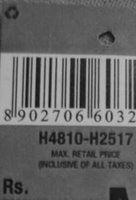
Commonsense tells us to check for the Maximum Retail Price (MRP) while purchasing something. Shopping-sense incites us to bargain on that MRP. With the exception of the local flea markets our bargaining range varies from 5-20% of the quoted price. Usually I purchased blank writable CDs in loose, then shopping-sense told me that it would be cheaper to get them in bulk (all the while I’m copying something or the other). I walk into the neighbouring computer stationary market (not Nehru Place, but a smaller one with competing prices) and ask for a case of 50 CDs. “320 Rupees,” he says. “300,” I offer. “Fixed Price,” he replies pointing to the board hanging overhead. “Atleast he cheats one and all alike,” I console myself and hand him the cash.
Some mental mathematics tells me that at Rs. 6.40 a CD it was not a bad deal after all. I used to pay that cheat of a retailer Rs. 10 a piece for the same stuff. Then I notice to my surprise the MRP. Rs. 1025.00. That’s almost three and a quarter times of what I actually paid (the calculator puts it at 320.31%). I checked to ensure the genuineness of the contents. They seemed satisfactory.
The same stuff can also be sold at smaller towns (with lesser competition) at the ‘printed price.’ The consumer can’t argue much nor can he seek redressal at a consumer forum. The law states that the dealer can’t charge more than the MRP. The retailer pockets a humongous margin. The consumer pays the price for residing at the wrong place.
Many of us might have noticed, while getting a new cell phone the difference between the printed and the price offered. My brother says that he prefers branded clothes because they charge the same in Delhi as well as Dimapur. But the other day someone told me that retailers at smaller centres purchase seconds and sell them off at the original marked prices. Most buyers can’t see the difference. You ponder over the points while I scrutinise my new Levi’s.


I once bought a discman from the sonyworld at the MRP only to find out later that other dealers were selling at around 25% discount to the MRP, and so when i wanted to buy a rechargeable AA battery with the charger and when isaw that the MRP was 1800, i went not to a dealer but to the grey market directly and bargained a sony charger with 4 AA cells at 1000 bucks. well, i don’t if it is the cahrger or the bat but somethin doesn’t work.even after 3 hrs of recahrging, the bat conks out after about 10 shots from my digicam SHIT.
I use < HREF="http://www.evereadyindustries.com/batteries.shtm" REL="nofollow">Eveready’s rechargeable batteries<> for my digicam. A pack of four AA batteries and the charger cost me only Rs. 280. And they work fine. Thankfully I didn’t go for the Sony stuff, which the dealer was pressurising me to.
Things are always cheaper in North East than in South Part of India.. I always used to wonder how they gave such heavy discounts… on the MRP
yeah, things are certainly cheaper in the north-east. second, common sense goes out of the window when u shop. third, ur display pic really interferes with my concentration…spl request..get back to the old u.AquaM
hmmmmmmm thoughtful post. and i dont have any problem in opening the blogspot window